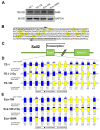mRNA and methylation profiling of radioresistant esophageal cancer cells: the involvement of Sall2 in acquired aggressive phenotypes
- PMID: 28367244
- PMCID: PMC5370508
- DOI: 10.7150/jca.15652
mRNA and methylation profiling of radioresistant esophageal cancer cells: the involvement of Sall2 in acquired aggressive phenotypes
Abstract
Esophageal squamous cell carcinoma (ESCC) is one of the deadliest malignancies worldwide. Radiotherapy plays a critical role in the curative management of inoperable ESCC patients. However, radioresistance restricts the efficacy of radiotherapy for ESCC patients. The molecules involved in radioresistance remain largely unknown, and new approaches to sensitize cells to irradiation are in demand. Technical advances in analysis of mRNA and methylation have enabled the exploration of the etiology of diseases and have the potential to broaden our understanding of the molecular pathways of ESCC radioresistance. In this study, we constructed radioresistant TE-1 and Eca-109 cell lines (TE-1/R and Eca-109/R, respectively). The radioresistant cells showed an increased migration ability but reduced apoptosis and cisplatin sensitivity compared with their parent cells. mRNA and methylation profiling by microarray revealed 1192 preferentially expressed mRNAs and 8841 aberrantly methylated regions between TE-1/R and TE-1 cells. By integrating the mRNA and methylation profiles, we related the decreased expression of transcription factor Sall2 with a corresponding increase in its methylation in TE-1/R cells, indicating its involvement in radioresistance. Upregulation of Sall2 decreased the growth and migration advantage of radioresistant ESCC cells. Taken together, our present findings illustrate the mRNA and DNA methylation changes during the radioresistance of ESCC and the important role of Sall2 in esophageal cancer malignancy.
Keywords: Esophageal squamous cell carcinoma (ESCC); promoter methylation, Sall2; radioresistance.
Conflict of interest statement
Competing Interests: The authors have declared that no competing interest exists.
Figures






Similar articles
-
Population and single‑cell transcriptome analyses reveal diverse transcriptional changes associated with radioresistance in esophageal squamous cell carcinoma.Int J Oncol. 2019 Dec;55(6):1237-1248. doi: 10.3892/ijo.2019.4897. Epub 2019 Oct 14. Int J Oncol. 2019. PMID: 31638164 Free PMC article.
-
The hypermethylation of the CDKN2A and CHFR promoter region is a key regulatory mechanism of CDKN2A and CHFR expression in esophageal squamous cell carcinoma.Transl Cancer Res. 2019 Jun;8(3):770-778. doi: 10.21037/tcr.2019.04.19. Transl Cancer Res. 2019. PMID: 35116815 Free PMC article.
-
PTK7 regulates radioresistance through nuclear factor-kappa B in esophageal squamous cell carcinoma.Tumour Biol. 2016 Oct;37(10):14217-14224. doi: 10.1007/s13277-016-5288-3. Epub 2016 Aug 24. Tumour Biol. 2016. PMID: 27557627
-
MiR-210 expression reverses radioresistance of stem-like cells of oesophageal squamous cell carcinoma.World J Clin Oncol. 2014 Dec 10;5(5):1068-77. doi: 10.5306/wjco.v5.i5.1068. World J Clin Oncol. 2014. PMID: 25493243 Free PMC article.
-
Krüppel-Like Factor 4 Enhances Sensitivity of Cisplatin to Esophageal Squamous Cell Carcinoma (ESCC) Cells.Med Sci Monit. 2017 Jul 11;23:3353-3359. doi: 10.12659/msm.902583. Med Sci Monit. 2017. PMID: 28694421 Free PMC article.
Cited by
-
Long non‑coding RNA BANCR promotes proliferation, invasion and migration in esophageal squamous cell carcinoma cells via the Raf/MEK/ERK signaling pathway.Mol Med Rep. 2021 Jun;23(6):465. doi: 10.3892/mmr.2021.12104. Epub 2021 Apr 21. Mol Med Rep. 2021. PMID: 33880577 Free PMC article.
-
A five-gene signature to predict the overall survival time of patients with esophageal squamous cell carcinoma.Oncol Lett. 2019 Aug;18(2):1381-1387. doi: 10.3892/ol.2019.10449. Epub 2019 Jun 7. Oncol Lett. 2019. PMID: 31423201 Free PMC article.
-
Nogo-B receptor increases the resistance to tamoxifen in estrogen receptor-positive breast cancer cells.Breast Cancer Res. 2018 Sep 12;20(1):112. doi: 10.1186/s13058-018-1028-5. Breast Cancer Res. 2018. PMID: 30208932 Free PMC article.
-
Epigenetic modification of SALL1 as a novel biomarker for the prognosis of early stage head and neck cancer.J Cancer. 2018 Feb 28;9(6):941-949. doi: 10.7150/jca.23527. eCollection 2018. J Cancer. 2018. PMID: 29581773 Free PMC article.
-
Casein kinase 2 phosphorylates and induces the SALL2 tumor suppressor degradation in colon cancer cells.Cell Death Dis. 2024 Mar 16;15(3):223. doi: 10.1038/s41419-024-06591-z. Cell Death Dis. 2024. PMID: 38493149 Free PMC article.
References
-
- Siegel RL, Miller KD, Jemal A. Cancer statistics, 2015. CA Cancer J Clin. 2015;65:5–29. - PubMed
-
- Enzinger PC, Mayer RJ. Esophageal cancer. N Engl J Med. 2003;349:2241–52. - PubMed
-
- Chen H, Wu Z, Chen J, Lin X, Zheng C, Fan Y. et al. Postoperative adjuvant therapy for resectable thoracic esophageal squamous cell carcinoma: a retrospective analysis of 426 cases. Med Oncol. 2015;32:417. - PubMed
LinkOut - more resources
Full Text Sources
Other Literature Sources

